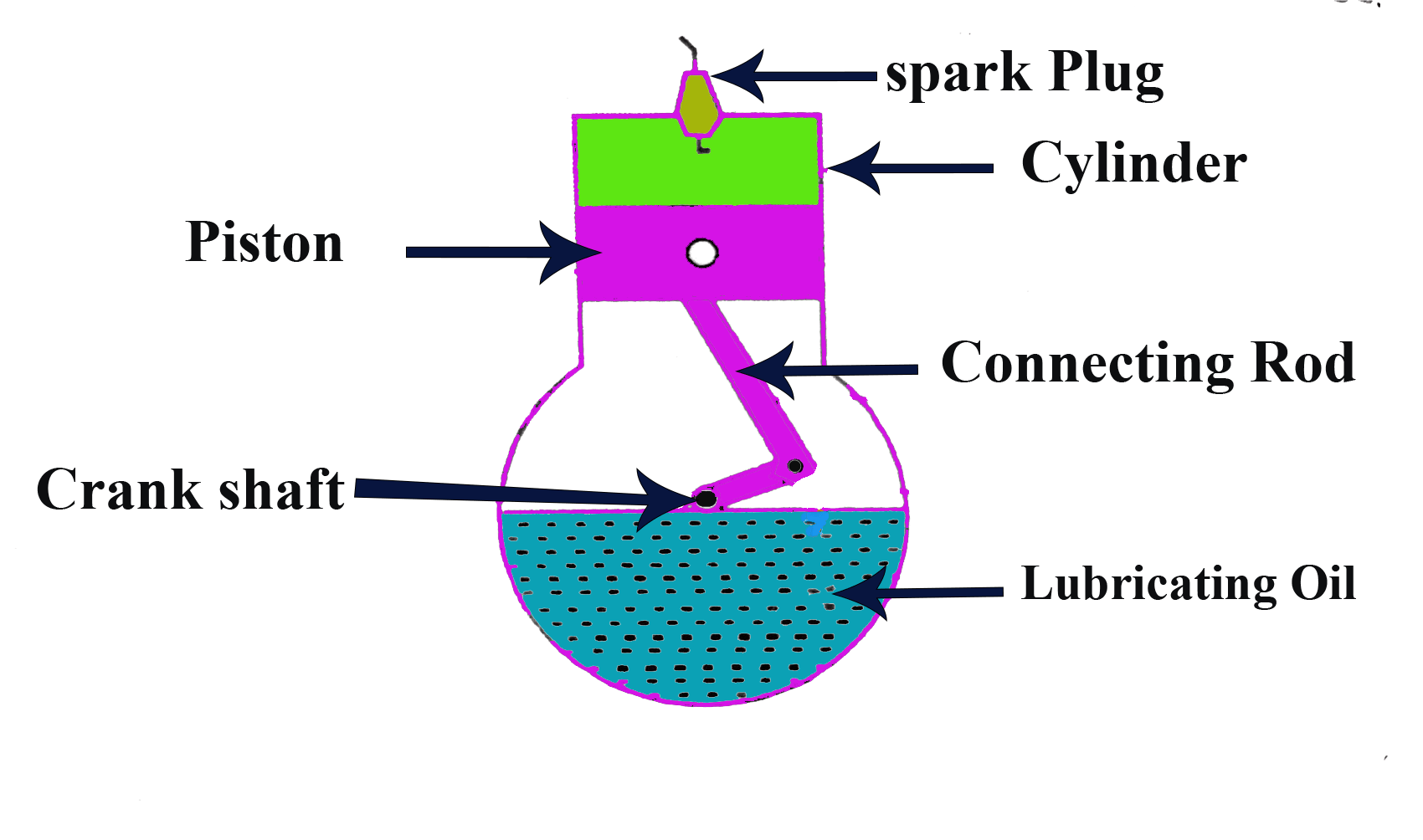Internal combustion engine
Internal combustion engines can be classified on various basis. What are the classifications of internal combustion engines Categorized here
Internal combustion engines depend on various types of fuel such as,
Combustion, number of strokes, number of cylinders, ignition system, cooling system, cycles
A complete recent classification of combustion, cylinder arrangement, internals is discussed below
For combustion engines, one should be familiar with engine classification.
Classification of IC engines based on type of fuel used
(A) Engines using volatile liquid fuels
Petrol, benzene, kerosene, alcohol etc.
(b) Engines using gaseous fuel
(c) Engines using solid fuel
Charcoal powder etc.
(D) Engines using viscous liquid fuel
Like heavy and light diesel oil.
(I). Dual fuel engines
Diesel, Petrol, Gas etc…
Classification of IC engines based on method of charging
(A) A naturally aspirated engine
A naturally aspirated engine is an internal combustion engine that depends on the intake of oxygen
Dependent only on atmospheric pressure and not on forced induction via turbocharger
A supercharger. Many sports cars use exclusively naturally aspirated engines to avoid this.
Turbo Lake.
(b) Supercharged engine
- A supercharger is a supercharger that increases the pressure or density of the supplied air.
- Internal combustion engine. This provides more oxygen for each intake cycle of the engine
- Burn more fuel and do more, increasing horsepower.
Classification of IC engines based on ignition type
(A) Battery ignition system
- In battery ignition systems, a battery is used to provide power for the ignition. It acts as storage
- energy and charged by a dynamo, which is driven by an engine. It converts it into chemical energy Electrical energy.
- Two types of batteries are used in spark ignition systems, lead-acid battery and alkaline battery.
- The former is used in light commercial vehicles and the latter in heavy vehicles
- Commercial Vehicles_ It is located on the primary side of the ignition coil. Compression Ignition (CI)
(b) Compression Ignition (CI) Engine: In this type of engine, the fuel is ignited as soon as it enters.
Contact with hot compressed air.
(b) Magnetic ignition system
- A magneto is a small electric generator that is rotated by a machine and is capable of producing a lot.
- No need for high voltage and batteries as external power source_
- The magnet has primary and secondary windings, so it does not require a separate coil.
- To increase the voltage required to operate the spark plug.
Classification of IC machines based on type of cooling
(A) Air cooled engine
Air-cooled engines rely on the circulation of air directly over the hot parts of the engine to cool them.
(b) Water cooled engine
Water cooling is a system of removing heat from factors. This is
Unlike air cooling, What are the classification of internal combustion engines water is used as a heat conductor for the heating element.
Water cooling is commonly used to cool internal combustion engines (ICE).
Classification of IC engines based on cylinder arrangement
(a) Vertical Engine: In this type of engine the cylinders are arranged in vertical position.
IC machine
(b) Horizontal engine: In this type of engine the cylinder can arranged in horizontal position.
(c) Inline Engine: In this type of engine, the cylinders can arranged inline
(d) Radial Engine: In this type of engine, the cylinders can arranged along the circumference of a circle.
(c) V-Engine: In this type of engine, the combination of two inline engines makes an equal angle,
Etc.
According to the number of strokes per cycle
(a) 4-Stroke Engine: In this type of engine, the work cycle can completed in four separate strokes.
(b) 2-Stroke Engine: In this type of engine, the work cycle can completed in two separate strokes.
According to the combustion cycle
(a) Otto Cycle Engine: What are the classification of internal combustion engines In this type of engine fuel can burned at constant rate.
(b) Diesel Cycle Engine: In this type of engine the combustion of fuel takes place continuously.
Pressure.
(c) Dual Combustion Engine: In this type of engine the fuel can burnt first.
constant volume and then constant pressure.
According to the number of cylinders
(a) Single cylinder engine: This type of engine has only one cylinder.
(b) Multi cylinder engine: This type of engine has 2, 3, 4, 6 or 8 cylinders.
By multiple strokes:
(a) Two-stroke engine: In a two-stroke engine, the cycle can completed in two revolutions (360 degrees).
Crankshaft, clerk cycle, day cycle
(b) Four-stroke engine (Otto cycle): In a four-stroke engine, the cycle can completed in four cycles.
of the crankshaft (720 degrees).
(c) Six-stroke engine: In a six-stroke engine, one cycle can completed in 6 revolutions (1080 degrees) of the crankshaft.
Mechanical classification
An engine can something that helps us, humans provide power that can used to perform a specific task. Imagine we are constantly pressing a transformer to get electricity!!! Instead we humans have developed a diesel engine that does this job for us. I would say that an engine is something that converts one form of energy into another form and consequently makes our life simpler and easier.
A machine may:
Heat Engine – A machine that converts heat energy into mechanical or electrical energy. Heat engines are usually prime movers.
External Combustion Engines (EC Engines) – Combustion of fuel occurs directly or indirectly outside the engine. A perfect example of this type of engine can a steam turbine, where fuel can burned in a boiler and the steam generated from the boiler can used to drive the turbine.
Internal Combustion Engine (IC Engine) – Engines where the combustion of fuel takes place inside the engine can called internal combustion engines. Simplicity in engine design, operating costs and fuel economy make these engines more popular and efficient than EC engines.
We are more interested in internal combustion engines as this type of engine can installed on motor ships.
Internal combustion engines are classified on the basis of:
Ignition System – Ignition system can be of two types namely compression ignition engine and spark ignition engine.
Compression Ignition Engine (CI Engine) – In this type of engine, the heat generated by compression inside the cylinder is high enough to produce fuel and consequently no other means are provided. causing the fuel to burn inside the cylinder. What are the classification of internal combustion engines A perfect example of a CI engine is a diesel engine. The diagram given below shows the working cycle of a diesel engine. Click this link to get an animated view of a diesel engine. Diesel engine animation. This type of engine is based on the diesel cycle.
Internal combustion engines can be classified based on strokes or cycles
Read More>>>> who invented the internal combustion engine
Rotation in a machine refers to the following phenomena:
Filling the engine cylinder with fresh air
As the air can compressed, the fuel vapors in contact with this compressed air, What are the classification of internal combustion engines which can now at a higher temperature due to the pressure, can ignited.
Fuel combustion
Exhaustion of these gases after moving the piston
In a word, a cycle consists of – intake – compression – power – expansion – exhaust.
Engines can divided into 2 classes based on how many strokes of the piston can required to complete this cycle.
Four-stroke engine – An engine that requires 4 strokes of the piston i.e. 2 times up and 2 times down to complete one cycle is a four stroke engine.
Two-stroke engine – An engine that requires 2 strokes of the piston i.e. 1 time up and 1 time down to complete one cycle is a two stroke engine. Read more




